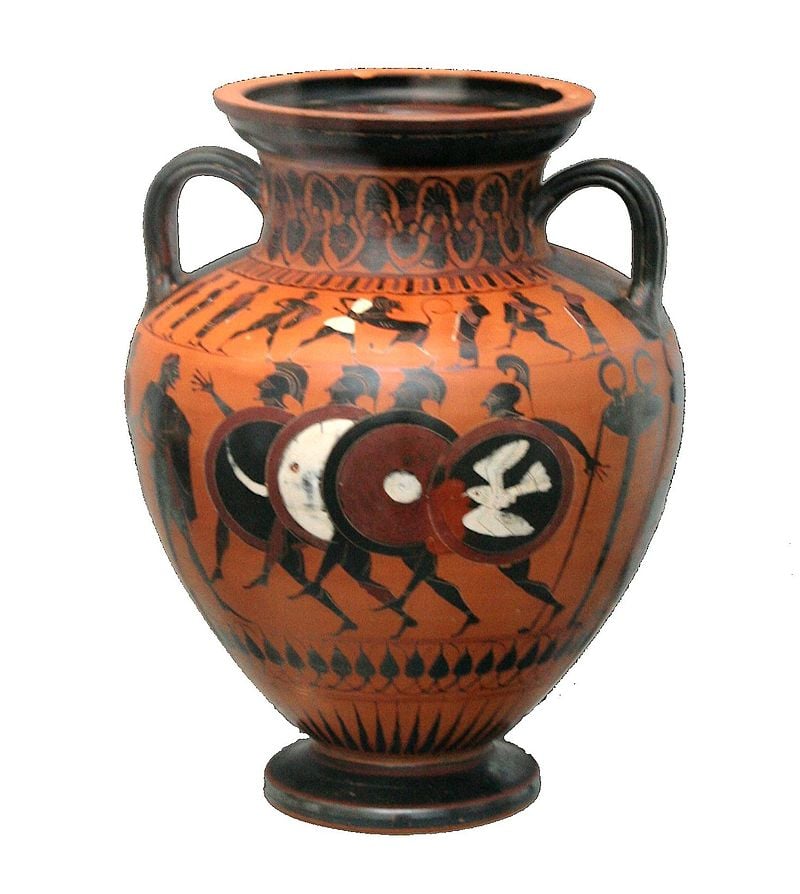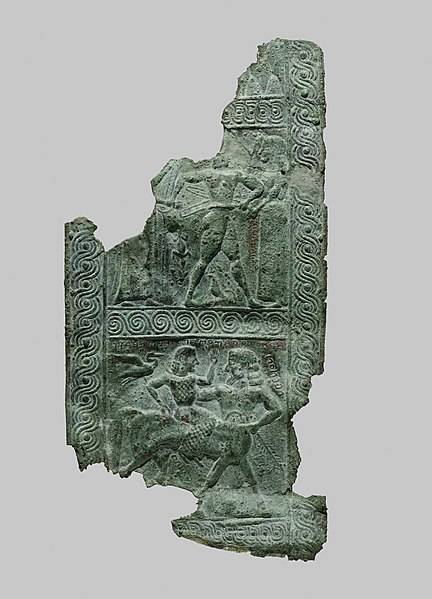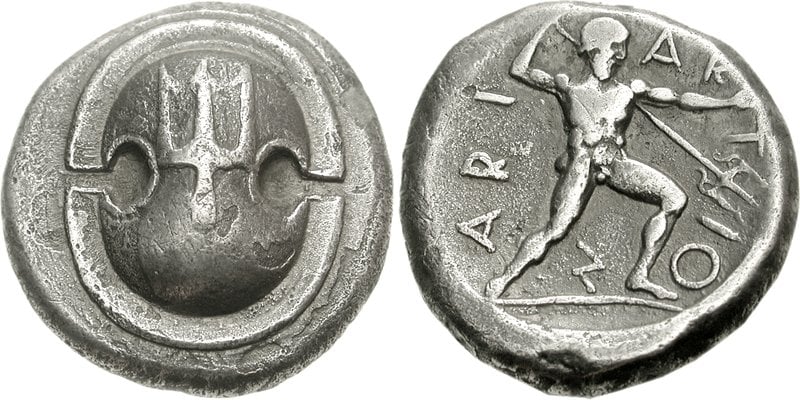
As far back as the eighth century BC, the ancient Greeks had invented a large, round shield called an aspis that would serve as an essential part of warfare through the Hellenistic era. The designs, or blazons, on these shields would strike fear in the hearts of their enemies.
Often called an “Argive” shield, it not only protected its owner in battle but showed his allegiance to a particular city-state or leader. The figures painted on its exterior were also often meant to show the courage of its bearer and to intimidate the enemy.
Arguably the most famous such decoration is that of the Spartans, also called the Lacedaemons, with a capital lambda (Λ). Beginning in the late 5th century BC, Athenian hoplites, or soldiers, commonly used an owl, the emblem of the goddess Athena, to signify their identity while the shields of Theban hoplites could be decorated with a sphinx, or the club of Heracles.
Greece’s great contribution to the use of the shield in battle was the double grip it employed. Known ever after as the Argive grip, it involved one handle for the hand placed at the edge of the shield with a leather fastening for the forearm at the center of the shield.

At a hefty sixteen pounds, this allowed the shield bearer to have more mobility and to better support the strategies of the phalanx. The shield would rest on the warrior’s shoulders and stretch all the way down to the knees.
They were designed for a mass of hoplites to push forward into the opposing army, a move called othismos, and it was their most essential equipment. That the shield was convex made it possible for warriors to use it as a flotation device for crossing rivers, and its large round shape allowed it to be used for hauling the bodies of the dead from the battlefield.
Hence, of course, the famous phrase uttered by Spartan women at one time to their men as they left for battle: “Come home with your shield or on it.”
These sturdy shields of the hoplites were much stouter than those of the Persians, who fought with the Spartans and other Greek soldiers at Thermoplylae.
The Persian soldiers, called Sparabara, held only wicker shields in front of them in battle, which were far inferior to the heavier wooden shield of the Greeks.
Although even larger than the Argive shields of the Greeks, the wicker shield naturally had no such protective capacity despite the two meter-long spears that the Persians used in battle.
This small bronze relief panel dating back to 575 BC was once sewn onto the leather strap inside a shield. Perhaps most amazing of all is that it bears an inscription, one of a man called Aristodms of Argos. Measuring 16.2 x 8 x 1.5 cm (6+3/8 × 3+1/8 × 9/16 in.), this piece is one of the earliest known signatures of a Greek artist.

At the top edge of the lower square, the signature of the bronzeworker is written in reverse, from right to left: “Aristodamos the Argive made (this).”
The intricately-made strap depicts two myths that were favored in that region of Greece. The upper panel represents the recovery of Helen of Troy by her husband Menelaos, king of Argos. Athena, the protectress of the Greeks, stands looking to the right.
The lower scene depicts the Centaur Nessos abducting Deianeira, the wife of the hero Herakles. The names of the figures are inscribed beside them.
The ancient Greeks sometimes considered shields to be valuable religious dedications, and shield straps are often found in the excavations of sanctuaries. Many such examples come from the Sanctuary of Zeus at Olympia, where worshippers left elaborate bronze shields as gifts to the gods.
The city of Argos in southern Greece was the major production site of this art form. Because the maker of this shield strap, Aristodamos, names himself as an inhabitant of Argos, this work can be taken as important evidence for the style of Argive art in the early Archaic period.

Shield blazons appear first on pottery dating back to the late eighth century.
Not all shields featured blazons, however, as there are plenty of vase paintings that leave the shield surface blank or painted a single color. Other shields featured abstract patterns, such as spirals or a number of flat circles, according to historians.
The most striking to our eye today are, of course, the shields bedecked with animals, monsters, or even human figures by artists of these ancient times. While most of these designs appear to have been painted, there are examples of bronze blazons from the Panhellenic sanctuary at Olympia, for example, that were cut from sheets of bronze featuring finely-carved details.
The blazons showing the faces of Gorgons or other figures from mythology were clearly meant to instill fear into the enemy. The Gorgon, a mythical creature with snakes instead of hair, of which Medusa is the best-known example, was one such creature portrayed on Ancient Greek shields.
However, Ancient Greek soldiers also employed symbols that represented themselves or qualities they admired, including a lion, which would symbolize strength and courage.
The snake, another common blazon, represented wisdom and immortality since snakes sloughed off their skins at regular intervals and were thought to renew themselves continually.
The Greek historian Herodotus wrote the following about Sophanes, the son of Eutychides, the bravest of the Athenian fighters at Plataea in 480 BC:
“Two different stories are told about him: one, that from the belt of his breastplate he carried an iron anchor slung from a bronze chain, which he would throw whenever he drew near his enemies so that when they broke out of their position in the ranks to assault him, they would be unable to budge him; then, when his opponents were in flight, his tactic was to pick up the anchor and chase them with it.”
Herodotus further explained that “That is one of the stories; according to the other…he did not actually wear an anchor attached to his breastplate, but instead had an anchor as an emblem on his shield, which never ceased moving and was always in swift motion.”
The Greek military commander Alcibiades (ca. 452-404 BC) had a golden shield, which according to Plutarch’s history of the time, sported an image of a thunderbolt-wielding Eros.
You might notice this wasn’t Zeus throwing his famed thunderbolt, but the god of erotic love, since he was the son of Aphrodite. Alcibiades’ shield emblem, therefore, was a rare and not so subtle reference to his sexual prowess, according to historians.
Even as far back as the fifth century BC, some Greek observers criticized the individual designs on shields. As historian Hans van Wees stated, some blazons were criticized for “betraying boastfulness and aggression, in contrast to the ‘modest’ undecorated shield of the wise man, and the simple white-painted shields of the common soldier.”
Fifth and fourth century BC saw rise of nation-state symbols as blazons
The lambda Λ mark on the shields of Spartan warriors do not appear to have been used prior to the Peloponnesian War, which took place in 431-404 BC, when they were referenced by the Attic playwright, Eupolis.
Historians believe it wasn’t until the end of the fifth and early fourth century BC that hoplites from some Greek city-states started to sport “national” emblems on their own shields, showing their allegiance to one particular area.
Thebans, of course, decorated their own shields with the club of Heracles. Soldiers from Sikyon were known to paint sigmas on their shields, and the Mantineans displayed the trident.
Athens oddly stands out as one area in which soldiers did not use any kind of state symbol on their shields. Any symbols found, for example on Attic pottery, appear to be those that appealed to the soldier for personal reasons.
Many other warriors from other city states must also have chosen shield blazons that represented their own personal expression.
See all the latest news from Greece and the world at Greekreporter.com. Contact our newsroom to report an update or send your story, photos and videos. Follow GR on Google News and subscribe here to our daily email!



